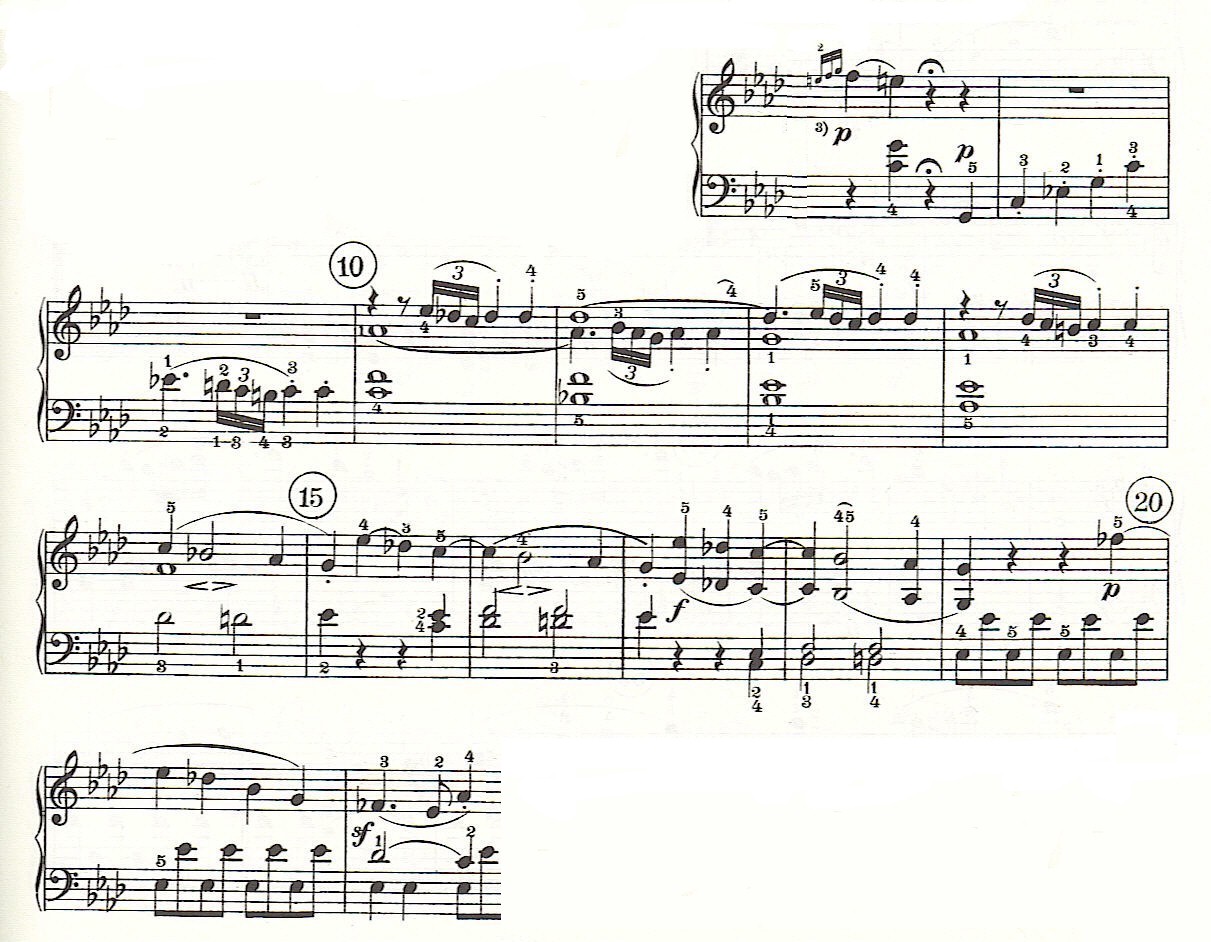 |
 |
Cadential Structure in Beethoven's Op. 2 No. 1 (First Movement) |
| The overall structural framework of many sonata-allegro movements is a double statement of the basic cadential idea - first as a half cadence [I-IV-V], and then as a full cadence [I-IV-V-I]. In such cases, the initial structural tonic is prolonged into the latter part of the development section before moving on to the structural subdominant and structural dominant. This is the case in the first movement of Beethoven's piano sonata in f minor, opus 2 no. 1. |
| This movement opens with a terse statement, in sentence form, of a structural half cadence (Example 241.1, from Ludwig van Beethoven Complete Piano Sonatas, v. 1, Heinrich Schenker, ed., Dover Publications, Inc., New York, 1975; for some reason, measure numbers appear at the end of every fifth measure - i.e., measure 5 has a large "5" in a circle over the bar line at the end of the fifth measure.) |
| The bass line is almost an exact retrograde of the melodic motive in measures 7 and 8. Measures 2 through 7 in the bass are, in fact, an exact retrograde of the melodic motive in measure 2. The initial tonic is prolonged from measure 1 to measure 5, by way of a first inversion dominant seventh in measures 3 and 4. Then from measures 5 to 7, the tonic is further prolonged by way of a second inversion dominant seventh. In measures 7 and 8, the bass reiterates the a-flat to b-flat to c-natural motion heard in the melody in measures 5 to 7. On the b-flat, we have the structural subdominant, and on the c-natural the structural dominant. In summary, we have the initial tonic prolonged for six and one-half measures, followed by a mere half-measure subdominant and a one-measure dominant. (It might be said that symphonic composition is the art of prolonging the initial structural tonic.) |
| The conciseness and concentrated interrelatedness of this opening statement is breathtaking. Nevertheless, after a brief rest, Beethoven simply moves on. Or so it would seem. |
| Having come to rest on the dominant - a c-major triad - the movement continues with a statement of the opening motive transposed to c minor, the dominant minor. This is the last we hear of this motive, for a while. Measures 9 to 20 constitute a transition, establishing a-flat major and introducing a second theme. The bass moves down stepwise, c-natural to b-flat to a-flat (mm. 11-14), a retrograde of the melodic motion in measures 5 to 7. Notice how the triad in measure 11 consists of the first three notes of the opening thematic motive. (Example 241.2, below.) |
| The embellishment motive, introduced in measure 2, dominates measures 11 through 14, but another idea is gently developed, a melodic descent from e-flat in measure 11 to g-natural in measure 15. This is repeated twice in measures 15 to 20. The descent of a minor sixth from e-flat to g-natural answers the rise from g-natural to e-flat in measures 9 and 10 and reiterates the descent of a minor sixth, from c-natural to e-natural, heard in measures 7 and 8. That was from the dominant note to the leading tone in f minor; this is from the dominant note to the leading tone in a-flat major. |
| The bass shows a similar transposition. The motion from a first-inversion tonic to a subdominant (first inversion supertonic) to the dominant (a bass-line motion from a-flat to b-flat to c-natural) in measures 7 to 8, is repeated in measures 16 through 20, transposed to a-flat major (a bass-line motion from c-natural to d-flat, and with an interposed d-natural, to e-flat). The idea heard in measures 16-18, and again in 18-20, is only a slightly modified version of the idea heard in measures 7-8, melodically and harmonically. The rhythm is significantly different. |
| The second theme begins in measure 20 with a reiterated octave figure on the dominant note, e-flat. The melody comes in on the upbeat to the next measure, reversing the order of entry of melody and accompaniment from the first theme. Another difference is that, while the first theme is squarely in f-minor, using precisely the seven notes of the harmonic minor scale, the second theme, supposedly in a-flat major, begins on an f-flat. Where does that come from? |
Introduction The Chaconne Cadential Structure --- Unitary & Binary Structures Linear & Periodic Structures Modules and Modalities Structural Counterpoint Modular Composition Appendices |
| These first eight measures constitute the entire first theme. The opening motive - a broken f-minor chord rising from middle c to a-flat almost two octaves above at the beginning of the second measure. This motion from c-natural to a-flat is developed motivically and harmonically, and is of major structural significance. The second statement of this rising motive rises to a b-flat, in measures 3 and 4. In measures 5 to 7, the a-flat to b-flat motion is repeated and continues upward to the c-natural to climax the phrase. We rose from c-natural to a-flat in measures 1 and 2, and from a-flat to c-natural in measures 5 to 7. From the high c-natural there is a scale-wise descent, with embellishment, to e-natural - a fall of a minor sixth, inverting the opening rise of a minor sixth. This descending motive and the related embellishment motive in measure 2 are reflected in the motion of the bass, and therefore in the harmonic progression, of these eight measures. |
| Example 241.1 |
 |
| Example 241.2 |
| MODULES Cadential Structure In Symphonic Composition: Analysis of Beethoven's Op. 2 No. 1 (First Movement) Lester Allyson Knibbs, Ph.D. |
| Sonata Movements Op. 2 No. 1 (I) 1 2 3 4 Op. 10 No. 1 (I) |